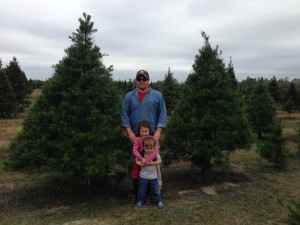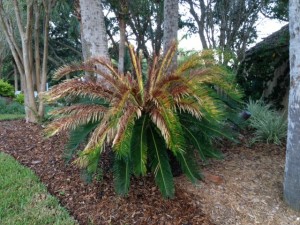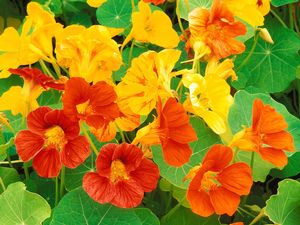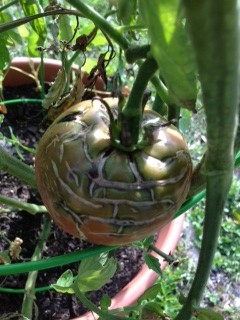by Mary Salinas | Nov 25, 2013

Whispering Pines Farm in Milton with proprietor Mike Kelly and children. Photo by Mary Derrick, UF IFAS.
One of the joys of this season is to bring home a fresh Christmas tree and enjoy the fragrance and natural freshness of a live tree inside your own home. Imagine how much fresher the tree would be if you harvested it!
The good news is there are Christmas tree farms in Northwest Florida where customers can choose and harvest their own Christmas tree! Visit the Florida Christmas Tree Association online to find the closest local Christmas tree farm. The website also offers information on tree varieties and how to care for harvested trees.
[notice] Here is a way to support your local farmer![/notice]
The varieties of trees grown in the panhandle are different from the northern trees brought south for the season. Christmas tree farms in the panhandle offer varieties such as Virginia pine, Leyland cypress, red cedar, Arizona cypress, Carolina sapphire, and Thuja “Green Giant’. Since these varieties do not grow naturally into the conical shape like northern-grown Christmas trees, the farmers take great care to train their trees into the traditional Christmas tree shape. Pruning and shaping the trees begins when they are about 2 years old and continues twice a year for as long as they are growing. The result is a tree that looks naturally shaped and ready for the tree stand.
Real Christmas trees are environmentally friendly as they are a renewable resource. Once trees are cut down, new ones are planted in their place. The trees are also reusable as mulch when chipped on-site or through county yard waste disposal services.
For additional information please see:
Christmas Trees and Their Care
Florida Christmas Tree Association
by Mary Salinas | Nov 4, 2013
For centuries, people annoyed with plant pests have used oils to control insects, mites, and even some fungal diseases. Current oil products are better than ever!

Sample oil products for pest control. Photo by Mary Derrick.
Commercially available horticultural oils are mineral oils from refined petroleum products. Impurities are removed and then an emulsifying agent is added that allows the oil to mix with water for application. Neem oil is a newer product that has become increasingly popular; the oil is an extract of the seeds of the neem tree.
What are some of the advantages of using an oil for pest control?
- Oils are inexpensive and easy to apply
- Oils can be used on most plants (check the label for a list!)
- Oils control a wide range of pests that feed on plants (again, check the label for a list of pests the product will control!)
- Oils pose a low risk to people, pets, and desirable beneficial predators
- Since oils kill pests by blocking their breathing holes (spiracles) and/or gumming up their mouthparts, there is no chance for resistance to develop
- One product can control both insects and some diseases like powdery mildew at once
- Oils can be combined with some other pesticides to provide greater control
[warning] Don’t combine with, or use within 30 days of, any sulfur based pesticide. The combination can harm your plants![/warning]
There are always drawbacks to a product. What are the drawbacks?
- Some plants (including cryptomeria, junipers, cedars, maples, and redbud) are damaged by oils – check the label!
- Ensure good coverage during spraying as pests must be contacted with the oil in order for the control to work
- Oils break down quickly and reapplication may be necessary
- Check the label for instructions on the temperature range when it can be used. Older formulations generally are safe when temperatures are in the 40 to 80°F range but ultra-fine oils can generally be safely applied during hotter weather.
For further information:
Natural Products for Insect Pest Management from UF IFAS Extension
Insect Control: Horticultural Oils from Colorado State University Extension
Less Toxic Pesticides from Clemson University Cooperative Extension
by Mary Salinas | Sep 23, 2013
Is the newest growth on your sago palm turning yellow, brown, frizzy looking and dying – is it a pest or disease or something else?

Photo credit: Mary Derrick
This sago palm is suffering from a classic case of manganese deficiency. When sago palms lack manganese, the newest leaves will develop yellow splotches or be entirely yellow. As the leaves die, they turn brown and take on a frizzled appearance. Sometimes the leaves or fruit may be smaller than normal. If left unchecked, the sago usually dies.
Manganese is a micronutrient required by all plants for normal, healthy growth and is most available for plant uptake when the soil pH is between 5.5 and 6.5. Soils in the Florida panhandle are often naturally low in manganese and then what available manganese is present can be unavailable for the plant to use if the pH of the soil is much above 6.5. Also, manganese tends to be leached from the soil when the pH is below 5.5. Soil pH and nutrient testing is useful to determine if soils are nutrient deficient. Contact your county Extension office for information on getting that done.
[notice]Before treating, rule out an infestation of Asian cycad scale. Click here for a UF IFAS Extension publication on this damaging insect. Be aware that both are common problems for sago palms and that your sago may be afflicted with both![/notice]
If this is happening to a sago palm, the good news is that it is easy to correct. Manganese sulfate is readily available at garden centers, feed &seed stores and independent nurseries. Just make sure to get manganese sulfate and don’t confuse it with magnesium sulfate (Epson salts). The amount of manganese sulfate necessary to correct this deficiency will vary with its size, soil type and pH. Sago palms in sandy, acidic soils require less manganese sulfate than those in high pH soils. One ounce is sufficient for a very small plant in sandy, acidic soil. A very large sago in a high pH soil may require about five pounds, however. Spread the product evenly over the root zone and water in with about a half inch of water.
The affected leaves cannot be cured but new growth should return to normal. If the new growth is still affected, an additional application of manganese sulfate may be needed. Once sago palms have suffered from a manganese deficiency, half the initial rate should be applied yearly to prevent the deficiency from re-occurring.
Even though sago palms are not true palms – they are cycads – their nutritional needs are very similar to palms. Most of the time they grow well without any supplemental fertilization, but if they do need fertilizing, use a 8-2-12-4 (the fourth number is magnesium) palm fertilizer with micronutrients and avoid using other fertilizer products in their root zones.
For more information on sago palms please see:
Cycas revoluta, Sago Palm
by Mary Salinas | Aug 23, 2013
Add the easy-to-grow garden nasturtium to your vegetable or flower garden!
Dress up a ho-hum salad with a vibrant blossom or two just like some of the high-end restaurants. The first taste you experience will be sweetness and then a pleasant peppery flavor emerges. Not only can you eat the flowers but the leaves can also be tossed into your salad and the immature seed pods can be pickled and eaten similar to capers.

Photo courtesy of the Mendocino Coast Botanical Garden
Garden nasturtium, known to botanists as Tropaeolum majus, is an annual that originated in the Andes of South America. Seed and plants are commonly found in garden centers, although a greater variety is available when purchased from seed catalogues or online. A variety of cultivars are available, from dwarf bushy types to climbing or trailing types. Perky blooms in vivid shades of orange, yellow, pink and red are often produced in abundance.
This annual is easy and fast to grow from seed. If transplanting from small potted plants, make sure not to disturb the delicate root system during the transplant process. Give them partial to full sun and regular watering, even though they are drought tolerant. They prefer a lighter, sandy, well-drained soil and don’t perform as well in dense, rich soils. Be careful with the fertilizer as too much nitrogen will produce lots of green foliage but few blooms.
[warning]Aphids like to feast on the succulent flowers and foliage as well, so be diligent in scouting for this pest. Control is usually adequate by dislodging them with a spray of water or insecticidal soap. Insecticidal soap will cause the aphid to try out and dessicate. Be careful to spray the undersides of the leaves as well for complete control. Make sure to apply products that are safe for food crops and follow all label instructions.[/warning]
In the Florida panhandle, garden nasturtium can be a part of the garden year-round. However, they generally decline and stop flowering with the onset of the full brunt of the summer heat unless a bit of afternoon shade is available. When planted late in the fall, they are susceptible to frost damage but often will recover.
.
For more information from the University of Florida, please see:
Garden Nasturtium, Tropaeoleum majus L.
Gardening in a Minute: Nasturtium

by Mary Salinas | Jul 7, 2013
Imagine this scenario: After you have heavily invested in your tomatoes, cracks appear on your previously perfect fruit just as they are starting to ripen.

Cracking in Cherokee Purple tomato
Credit: Mary Derrick, UF/IFAS
How frustrating! Depending on the severity of the cracking the fruit will still ripen and be edible, although blemished. However, if cracking is severe, insect and disease pests may take advantage of the weakened skin and feast on the tomato.
Why does this happen?
When tomato plants have fluctuations in the amount of available water in the soil, the skin becomes susceptible to cracking. This occurs when tomatoes are allowed to dry out, then heavily watered. The excess in available moisture causes the inside of the fruit to grow more rapidly than the skin, thus cracking appears. As tomatoes grow toward maturity, they become more prone to cracking. Wide fluctuations in air temperature can also contribute to cracking.
Avoid cracking in your fruit by following these simple suggestions:
• Keep your plants evenly moist through regular irrigation and mulching
• Shade fruit with ample foliage cover
• Select varieties or hybrids that are known to resist cracking
• Harvest susceptible tomatoes at an earlier stage of development and ripen indoors.
Happy Gardening!
For additional information follow these links:
Tomatoes in the Florida Garden
Physiological, Nutritional, and Other Disorders of Tomato Fruit






